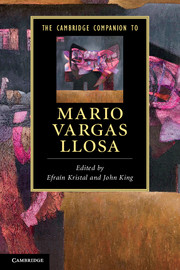Book contents
- Frontmatter
- Introduction
- 1 Reality and rebellion: An overview of Mario Vargas Llosa’s literary themes
- 2 The early novels: The Time of the Hero and The Green House
- 3 The total novel and the novella: Conversation in The Cathedral and The Cubs
- 4 Humour and irony: Captain Pantoja and the Special Service and Aunt Julia and the Scriptwriter
- 5 The historical novel: The War of the End of the World
- 6 Innocence and corruption: Who Killed Palomino Molero? and The Storyteller
- 7 The political novels: The Real Life of Alejandro Mayta and Death in the Andes
- 8 The erotic novels: In Praise of the Stepmother and The Notebooks of Don Rigoberto
- 9 The dictator novel: The Feast of the Goat
- 10 From utopia to reconciliation: The Way to Paradise, The Bad Girl and The Dream of the Celt
- 11 The essays
- 12 The memoir: A Fish in the Water
- 13 The plays
- 14 Film and the novels
- 15 An interview
- Further reading
- General index
- Index of selected fictional characters
- Index of selected works by Vargas Llosa
8 - The erotic novels: In Praise of the Stepmother and The Notebooks of Don Rigoberto
Published online by Cambridge University Press: 28 January 2012
- Frontmatter
- Introduction
- 1 Reality and rebellion: An overview of Mario Vargas Llosa’s literary themes
- 2 The early novels: The Time of the Hero and The Green House
- 3 The total novel and the novella: Conversation in The Cathedral and The Cubs
- 4 Humour and irony: Captain Pantoja and the Special Service and Aunt Julia and the Scriptwriter
- 5 The historical novel: The War of the End of the World
- 6 Innocence and corruption: Who Killed Palomino Molero? and The Storyteller
- 7 The political novels: The Real Life of Alejandro Mayta and Death in the Andes
- 8 The erotic novels: In Praise of the Stepmother and The Notebooks of Don Rigoberto
- 9 The dictator novel: The Feast of the Goat
- 10 From utopia to reconciliation: The Way to Paradise, The Bad Girl and The Dream of the Celt
- 11 The essays
- 12 The memoir: A Fish in the Water
- 13 The plays
- 14 Film and the novels
- 15 An interview
- Further reading
- General index
- Index of selected fictional characters
- Index of selected works by Vargas Llosa
Summary
Sexual themes figure prominently in all of Vargas Llosa's novels. In many of his essays and in some of his creative writings, he has been influenced by Georges Bataille's views on the erotic. However, the erotic is not only of aesthetic interest to him; it also has moral and even political implications. As he indicates in an epigraph for an illustrated book, Erotic Drawings: ‘Eroticism has its own moral justification because it says that pleasure is enough for me; it is a statement of the individual's sovereignty.’ That being said, as a writer of erotic narrative fiction, he is primarily identified with two novels, In Praise of the Stepmother (Elogio de la madrastra, 1988) and its sequel, The Notebooks of Don Rigoberto (Los cuadernos de Don Rigoberto, 1997).
Differences and similarities
Although they are intended to be read as companion pieces, obvious differences separate the two works. The Stepmother consists of 149 pages divided into fourteen chapters and an epilogue, with six chapters each incorporating a colour reproduction of a famous painting. The novel operates on two principal levels of reality: the ‘actual’, which consists of an objective, third-person narration of episodes occurring in a household in contemporary Lima; and the ‘mythical’, in which the paintings seem to come alive and address the reader in the first person. The Notebooks consists of 304 pages divided into nine chapters and an epilogue, with each chapter structured symmetrically into four sections, except for Chapter 2, which includes a fifth section as a follow-up to its second section.
- Type
- Chapter
- Information
- The Cambridge Companion to Mario Vargas Llosa , pp. 102 - 115Publisher: Cambridge University PressPrint publication year: 2011



